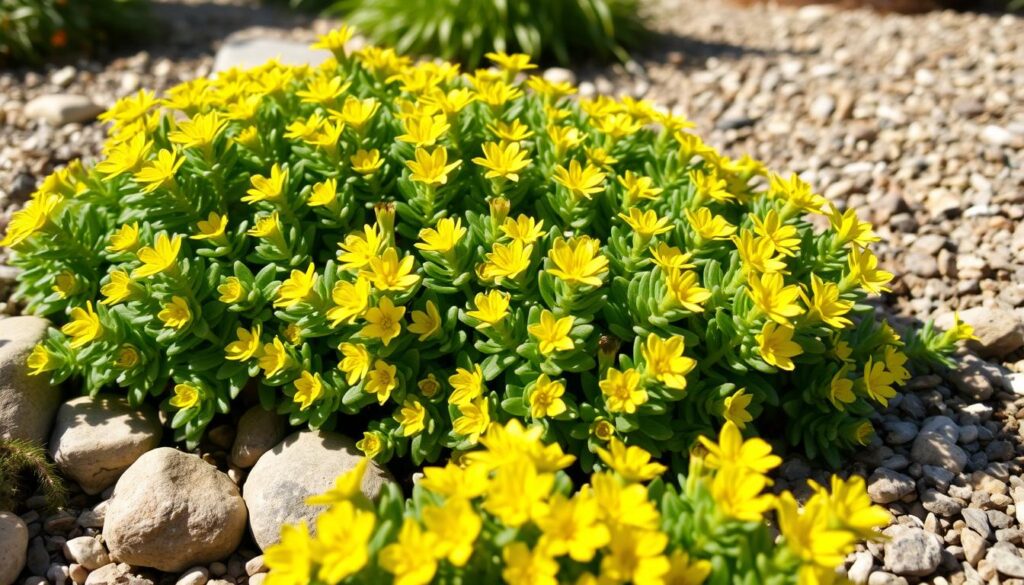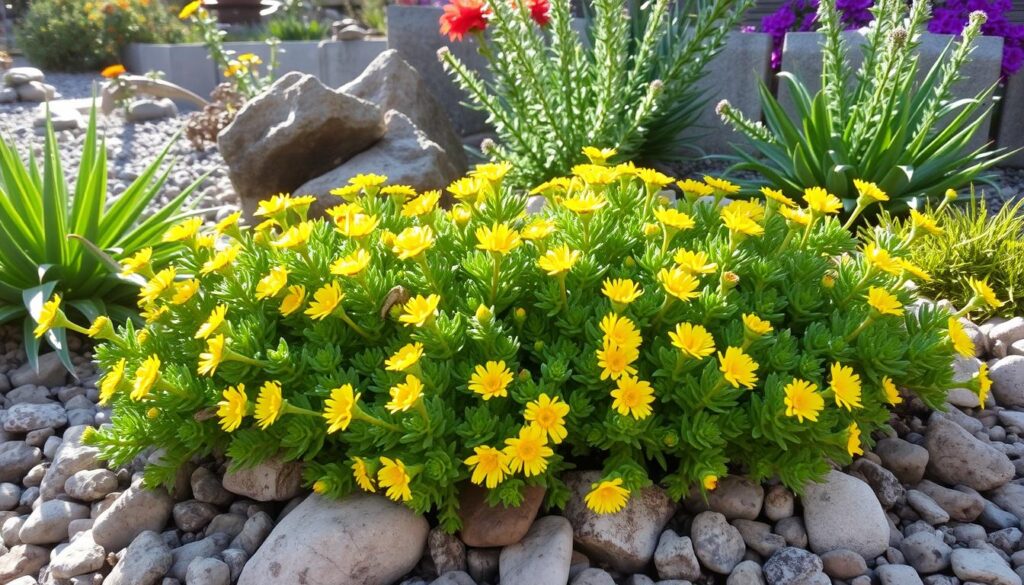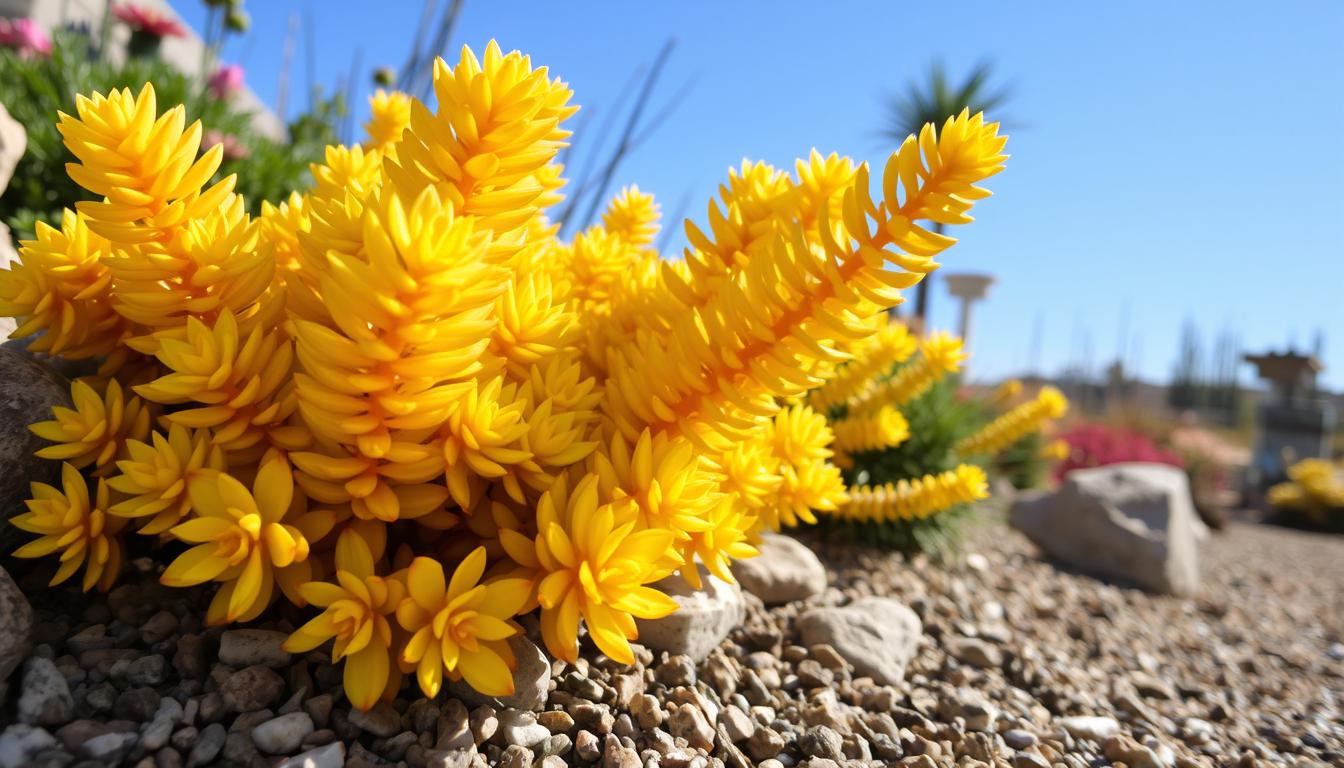As summer fades and autumn arrives, Angelina Sedum shines in the garden. This perennial ground cover dazzles with its golden-yellow leaves. It brightens any landscape, perfect for both experienced and new gardeners.
Table of Contents
Understanding Angelina Sedum: A Versatile Ground Cover
Angelina sedum, also known as stonecrop angelina, is a captivating ground cover. It has become popular among gardeners and landscapers. This low-growing, mat-forming perennial boasts vibrant, golden-yellow foliage. It adds a stunning visual element to any garden or outdoor space.
Characteristics of Stonecrop Angelina
The Angelina sedum plant belongs to the Sedum genus, a diverse group of succulent plants. It thrives in various growing conditions. Its small, fleshy leaves have a unique, spoon-like shape. The foliage often turns reddish or bronze in colder months, adding depth and interest.
Natural Habitat and Growth Patterns
Angelina sedum is native to parts of Europe and Asia. It grows in rocky, well-drained areas and slopes. In its native environments, it adapts to harsh, dry conditions and thrives in full sun.
In gardens, the angelina sedum plant spreads to form a dense, mat-like ground cover. It’s an excellent choice for covering bare areas, cascading over walls, or filling in between pavers.
The stonecrop angelina is known for its ability to tolerate a wide range of soil types and climatic conditions. This makes it a versatile option for various garden settings.
“Angelina sedum is a true showstopper in the garden, with its vibrant, golden-yellow foliage that adds a burst of color and texture to any landscape.”
Benefits of Growing Angelina Sedum in Your Landscape
Adding Angelina sedum to your garden brings many benefits. It’s a low-maintenance, drought-tolerant ground cover. Let’s look at why it’s great for your landscape.
Angelina sedum stands out for its drought tolerance. It does well in dry spots, perfect for areas with little water. This means you won’t need to water it as often, saving you time and water.
This plant also fights weeds. Its dense growth blocks weeds, so you don’t have to weed as much. This makes it a smart choice for those who want a low-maintenance ground cover.
Angelina sedum also adds beauty to your garden. Its bright yellow leaves stand out against other plants. It fits well in many garden styles, from formal to natural.
Finally, it attracts pollinators. Its small flowers draw bees and butterflies, helping your garden ecosystem. This makes your garden a better place for wildlife.
“Angelina sedum is a true workhorse in the garden, providing a beautiful, low-maintenance ground cover that enhances both the aesthetics and the ecological value of any landscape.”
Angelina sedum is perfect for a drought-resistant, weed-free garden. It adds color and interest to your outdoor spaces. It’s a versatile and practical choice for any garden.
Ideal Growing Conditions for Angelina Sedum
To make your angelina sedum stonecrop grow well, you need to give it the right conditions. It likes certain soil, light, and temperature. These are key things to think about.
Soil Requirements and Preparation
Angelina sedum stonecrop does best in well-draining, sandy or rocky soil. The pH should be neutral to slightly alkaline. The soil should be rich but not too fertile, as too much can make the leaves grow too much.
Before planting, mix in compost or organic matter. This helps with drainage and adds nutrients.
Light and Temperature Preferences
This plant loves the sun but can handle some shade. It’s hardy in USDA zones 4 to 9. But, it needs protection from too much heat in summer.
Climate Zone Considerations
- In cooler places, angelina sedum stonecrop is great because it can handle frost and light snow.
- In warmer areas, give it afternoon shade or dappled sunlight to avoid heat stress.
- No matter where you are, make sure the soil drains well. This prevents waterlogging and root rot.
Knowing the best growing conditions for angelina sedum stonecrop helps it thrive in your garden.
When and Where to Plant Angelina Sedum
Timing is key when planting the angelina sedum plant or stonecrop angelina sedum. They do best in spring or fall when the soil is moist and the weather is mild. Planting in the scorching summer or freezing winter can be tough for them.
Choosing the right spot is important for the angelina sedum. They’re great in rock gardens, cascading over slopes, and in containers. Their low-growing habit is perfect for filling gaps and covering bare spots.
- Rock gardens: The angelina sedum plant’s vibrant golden foliage and drought-tolerant nature make it a perfect addition to well-drained, sun-exposed rock gardens.
- Slopes and hillsides: The trailing growth habit of the stonecrop angelina sedum helps to stabilize slopes and prevent soil erosion.
- Container plantings: Grow angelina sedum in pots, baskets, or other containers for a striking display on patios, decks, or balconies.
When picking a spot, think about your garden’s microclimate. Angelina sedum loves full sun and well-draining soil. Choose a location that matches these needs for the best growth.
“Angelina sedum is a versatile and resilient ground cover that can transform any garden with its vibrant, golden-hued foliage.”
Planting Techniques and Spacing Guidelines
Growing Angelina sedum in your garden offers two main choices: container or ground planting. It’s important to follow spacing guidelines for the plants’ success and beauty.
Container vs. Ground Planting
For container planting, pick a potting mix that drains well and a container with holes. Angelina sedum likes shallow, wide planters for its stems to spill over. In the ground, choose a sunny spot with good drainage and enough space for the plants to spread.
Proper Spacing Methods
- In containers, space Angelina sedum 6-12 inches apart for their natural spread.
- For ground planting, space them 12-18 inches apart to prevent overcrowding.
- Plant them 1-2 inches deep, as they prefer shallow roots.
- Water them well after planting to help the roots grow.
By using these planting and spacing tips, your Angelina sedum will flourish. It will bring a lively splash of color to your garden or containers.
Essential Care and Maintenance Tips
Caring for your Angelina sedum, also known as stonecrop, is key to keeping its bright, golden-yellow leaves. This hardy perennial needs little care but a few practices can help it thrive. These tips will keep your garden looking great for a long time.
Fertilization Needs
Angelina sedum doesn’t need much food. In early spring, use a balanced, slow-release fertilizer. Follow the instructions to give it the nutrients it needs for growth and color.
Pruning and Deadheading
Pruning and deadheading keep the plant looking neat and encourage new growth. Cut off dead or damaged leaves in early spring. Also, remove spent flowers all season to keep it blooming.
General Maintenance
- Watch for pests or diseases and deal with them quickly to stop them from spreading.
- Don’t let the plant get too wet, as it likes well-drained soil.
- Every 2-3 years, divide the clumps to refresh the plant and promote new growth.
By following these care and maintenance tips, your Angelina sedum will stay vibrant and healthy in your garden for years.

“Angelina sedum is a hardy, versatile perennial that adds a pop of color and texture to any garden.”
Watering Requirements and Drought Tolerance
The angelina sedum plant, also known as stonecrop angelina sedum, is famous for its drought tolerance. It grows well in well-drained soils and needs little water. This makes it a great choice for those who want easy-to-care-for ground cover.
Seasonal Watering Schedule
In the growing season, the angelina sedum plant needs water when the soil feels dry, about once a week. But, you might need to water more often in hot, dry summers. This helps prevent the plants from drying out.
In cooler months, you can water every two to three weeks. The plant is dormant and needs less water. Always check the soil moisture and adjust your watering schedule to keep the plant healthy and vibrant all year.
Signs of Over and Under Watering
- Signs of over-watering include yellowing or wilting leaves, and fungal diseases or root rot. If you see these, water less and make sure the soil drains well.
- Signs of under-watering include shriveled, crispy leaves and slow growth. If the plant looks stressed, give it a good, deep watering to help it recover.
Knowing how to water the angelina sedum plant helps you create a beautiful, easy-to-care-for garden feature. It adds beauty and function to your outdoor space.
Propagation Methods for Angelina Sedum
Looking to grow more angelina sedum or perennials? Propagation is a great way to do it. This succulent has several easy methods to grow new plants from old ones. Let’s look at how to propagate angelina sedum and enjoy its bright foliage in your garden.
Division
Division is a simple way to propagate angelina sedum. Dig up the plant in spring or fall. Then, separate the clusters of rosettes into smaller sections. Make sure each section has its own roots.
Replant the divisions in well-draining soil. Water them well.
Stem Cuttings
Angelina sedum can also be grown from stem cuttings. Cut 4-6 inch pieces from healthy stems. Remove the lower leaves and let the cuttings dry for a few days.
Plant the cuttings in a well-draining mix. Keep them moist until new growth shows up, usually in a few weeks.
Leaf Propagation
- Angelina sedum is easy to propagate from leaves. Twist off a healthy leaf and let it dry for a day or two.
- Plant the leaf in a well-draining mix, burying the end slightly. Keep the soil moist. New plantlets will form along the leaf edges in a few weeks.
Choose your propagation method and be patient. Give the new plants the right conditions: well-draining soil, sunlight, and moderate watering. With care, enjoy the golden-yellow foliage of angelina sedum in your garden.
Common Problems and Solutions
Angelina sedum, also known as stonecrop, is a hardy perennial that needs little care. But, like any plant, it can face pests or diseases. Knowing these issues and how to solve them will help your Angelina sedum grow well in your garden.
Pest Management
Aphids, mealybugs, and spider mites often target Angelina sedum. These pests suck sap, causing color changes, slow growth, and plant decline. To fight them, introduce beneficial insects like ladybugs or lacewings. They eat these pests.
You can also use organic insecticidal soaps or horticultural oils. These methods control pests without harming your Angelina sedum’s leaves.
Disease Prevention
Angelina sedum is prone to root rot from too much water or poor drainage. Plant it in well-draining soil and avoid waterlogged soil. Also, watch out for leaf spot diseases that can ruin the leaves.
Keep your Angelina sedum well-ventilated and avoid overhead watering. This reduces the chance of fungal infections.
By watching for pests and diseases and acting fast, you can keep your Angelina sedum stonecrop healthy. It will remain a beautiful, easy-to-care-for perennial in your garden.

Companion Plants and Garden Design Ideas
The angelina sedum plant is a great choice for a beautiful garden. It works well with many plants, thanks to its adaptability. This makes it perfect for adding color and texture to your garden.
Rock gardens are a great place to show off the angelina sedum plant. Its bright yellow leaves stand out against the natural rocks. Adding succulents like sempervivum and echeveria makes the garden even more interesting.
In a traditional garden, the angelina sedum plant makes a beautiful border. It looks great with taller plants like coreopsis or echinacea. This mix of heights and colors is very appealing.
In container gardens, the angelina sedum plant is a standout. It spills over the sides of pots, adding color. Pair it with plants like lavender or rosemary for a beautiful, easy-to-care-for display.
“The angelina sedum plant is truly a versatile and captivating addition to any garden. Its vibrant color and low-maintenance nature make it a must-have for homeowners seeking a dynamic and drought-tolerant groundcover.”
Seasonal Care Through the Year
Caring for your angelina sedum, a type of perennials, needs a seasonal plan. This ensures the plant stays healthy and looks great all year. Let’s look at what you need to do in each season.
Spring Awakening
When spring comes, your angelina sedum will start to wake up. It’s time to remove any dead or damaged leaves. This helps the plant grow new leaves.
Also, give it a light, balanced fertilizer. This will help it grow strong and healthy.
Summer Maintenance
In summer, your angelina sedum needs regular water to stay bright and yellow. Remember, it’s okay if it gets a little dry sometimes. Just don’t let it get too dry.
Also, remove any dead flowers. This makes the plant look neat and encourages more flowers to grow.
Fall Preparation
As fall comes, start getting your angelina sedum ready for winter. Water it less and let it start to sleep. In late fall, add some mulch around the base. This keeps the roots warm and safe.
Winterizing Tips
To keep your angelina sedum safe in winter, protect it from cold. If it’s very cold where you live, cover it with evergreen branches or a light cloth. This keeps it green and healthy during the cold months.
“Proper seasonal care is the key to a thriving angelina sedum in your garden.”
By following these seasonal care tips, your angelina sedum will stay beautiful all year. It adds a bright and easy-to-care-for touch to your garden.
Conclusion
In this guide, we’ve looked at the amazing Angelina sedum stonecrop. It’s a versatile perennial that can make your garden pop with its bright foliage. You now know how to grow this easy-to-care-for plant in your garden.
Angelina sedum is great because it’s tough and doesn’t need much water. It attracts pollinators, adds color all year, and makes your garden interesting. You can plant it in pots or directly in the ground, and it will look amazing.
With the right care, Angelina sedum will flourish. It will make your garden beautiful for many years. Let Angelina sedum turn your garden into a stunning, easy-to-care-for outdoor space.

